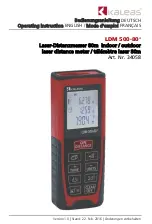
Concepts and Features
R&S
®
ZNA
208
User Manual 1178.6462.02 ─ 12
The figure above also shows the possible output frequencies of the two mixers. The
actual values of f
int
and f
IF
depend on the RF and LO frequencies and of the measured
conversion (lower sideband or upper sideband with up- or down-conversion). The ana-
lyzer automatically calculates all frequencies and sets its receiver according to the set-
tings made.
A test setup with two mixers requires 3 independent source ports plus one receive port.
Only a 4-port R&S
ZNA with
ZNAff-B3) does not
require external generators.
A standard mixer measurement with a single mixer stage and no frequency multipliers
corresponds to the figure above with the second mixer and LO 2 omitted and m
1
= n
1
=
m
2
= n
2
= 1.
Mixer Diagrams
The mixer signal diagrams show the parameters of the mixer input signals (RF, LO)
and of the mixing product (IF signal, output).
●
The RF signal is the stimulus signal that the analyzer generates with the current
channel settings. After a reset, the frequency and power of the RF signal is as
defined in the Channel – Stimulus menu. The RF signal parameters can be
changed in the "Power" and "Frequencies" dialogs.
●
The Local Oscillator (LO) signal is an additional RF signal that is either generated
by the network analyzer (at one of the ports that are not used for the RF and IF
signals) or by an external generator. A test setup with two mixers involves two inde-
pendent LO signals at both mixers.
●
The IF signal is the mixer output signal (mixing product), which is at one of the fol-
lowing conversion frequencies: IF = LO + RF or IF = |LO – RF|, i.e. LO – RF (for
LO > RF) or IF = RF – LO (for RF > LO). The IF frequency is selected in the "Fre-
quencies" dialog. A test setup with two mixers involves two independent conver-
sion settings.
The signal description above, with the swept RF signal and the LO signal at a fixed fre-
quency, corresponds to the default configuration. In the "Frequencies" dialog, you can
select any of the signals as a "Sweep/CW" signal. You can set the frequency range for
this signal via "Start/Stop" or "CW Frequency". A second signal is at a "Fixed" fre-
quency, and the third at the calculated sum or difference frequency ("Auto").
The labeling of the complete diagrams depends on the sweep type.
●
The following mixer signal diagram corresponds to a
frequency sweep
:
Optional Extensions and Accessories
















































